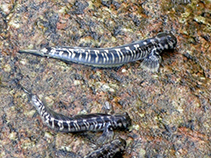| Family: |
Blenniidae (Combtooth blennies), subfamily: Salariinae |
| Max. size: |
10 cm TL (male/unsexed) |
| Environment: |
demersal; brackish; marine |
| Distribution: |
Western Indian Ocean: Comoros, Madagascar, Seychelles and Mascarenes Islands. |
| Diagnosis: |
|
| Biology: |
It is an amphibious blenny that inhabits exposed and moderately exposed rocky intertidal habitats (Refs. 120780, 130806). It is occasionally found in the mouths of rivers. The actual occurrence of this euryhaline species in freshwater is uncertain (Ref. 4342). It stays above the water line on moist or wet surfaces as it moves both vertically and horizontally with the tide. Feeds on emerged microscopic algae scraped from the rocks (Ref. 130806). Oviparous (Ref. 205). Eggs are demersal and adhesive (Ref. 205), and are attached to the substrate via a filamentous, adhesive pad or pedestal (Ref. 94114). Larvae are planktonic, often found in shallow, coastal waters (Ref. 94114). |
| IUCN Red List Status: |
Least Concern (LC); Date assessed: 23 March 2009 Ref. (130435)
|
| Threat to humans: |
harmless |
Source and more info: www.fishbase.org. For personal, classroom, and other internal use only. Not for publication.

